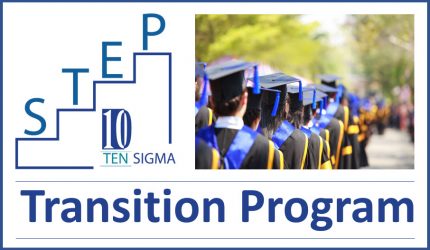22 Oct Student Engagement Before, During, and After the IEP Meeting

Have you ever left an IEP meeting wondering:
“How can I get students more involved in the meeting and the Transition process in general?”
You are not alone!
At the CEC (Council for Exceptional Children) national conference last year, we asked a room of Special Educators,
“What percentage of time are your students actively engaged during their IEP meetings?”
Unfortunately, their average response was less than 10% of the time. That is not just an isolated issue for that specific group of educators. We have heard similar responses from teachers across the country for years. Some teachers have expressed that they often feel like students are “passengers” in this process instead of being active participants.
Think of Transition in Three Categories
Due to things like increasing academic requirements, the large amount of documentation required in special education, and limited or no direct instruction time to focus on Transition, it's easy to understand why many educators struggle to find ways to engage students throughout their Transition process.
Another challenge is limited communication between teachers, parents, and students about Transition between IEP meetings. We all know that the IEP team focuses on postsecondary goals and Transition planning during the IEP meeting, but many teachers have told us that their students are not having conversations about their postsecondary goals between IEP meetings.
An approach that is very helpful to address these challenges is to think about Transition in three categories – before, during, and after the IEP meeting.
Before the IEP Meeting
Because preparing for an IEP meeting requires a lot of documentation and preparation by the special education teacher and members of the IEP team, student involvement and ownership in their own Transition process is critical.
Overall Goal of Increasing Student Involvement: To the greatest extent possible, the ideal goal for Transition success is to involve students throughout their Transition process – including from year-to-year until they graduate or complete the program.
- Exploring Postsecondary Goal Options – While many educators use a variety of formal, age-appropriate assessments and we also recommend using informal assessments like surveys, interests inventories, interviews, etc. to help students explore their options.
- Researching More About Options – Once students have begun narrowing their options, consider having them do some research about specific areas of interest. This could include interviewing parents, trusted adults, volunteering, etc.
- Identifying Proposed Postsecondary Goals – Schedule at least one short meeting with students before their IEP meeting to review results of assessments, their interests, and guide them to identify proposed goals.
- Sharing Proposed Postsecondary Goals with Parents – It is important to encourage communication between students and parents throughout the Transition process. Talk with students about sharing their goals and getting feedback from parents or guardians before the IEP meeting.
- Guiding and Preparing Students to Lead a Portion of Their IEP Meeting Discussion – Self advocacy is an important skill that is used throughout adult life. One way to teach this is to empower students (to the best of their ability) to explain what they have done to identify their goals, receive feedback from the IEP team, and answer questions.
Important Note: This process applies to students who are updating their postsecondary goals each year after their initial Transition IEP meeting.
During the IEP Meeting
As we know, the purpose of education is to prepare students to lead a positive, productive, and happy adult life. The IEP meeting is an important time because the IEP team is there to support the student in making a successful transition.
Admittedly, there is a lot to accomplish during a meeting and one of the most important goals should be to increase student ownership and engagement in the meeting. This will help to ensure that the IEP team is talking with students instead of about them and will inherently foster student engagement.
- Help Students Understand The Importance of the IEP Meeting and Their Role in It – We realize that some students are facing significant challenges which can make it difficult for them to comprehend or actively participate in IEP meetings. To the greatest extent possible, it is imperative for teachers to talk with students and explain the role the IEP meeting has in their academic life as well as in their future. It is especially helpful for teachers to reinforce the importance of the IEP, the IEP team, and the Transition process over the years that students are in the school or program.
- Guide Students to Lead a Portion of the IEP Meeting – To the greatest extent possible prior to the IEP meeting, help students to practice how they will lead part of the discussion during the IEP meeting. One great tool that can help in this area is a script. We suggest developing a simple form that students can read at the meeting to help them explain what they have done regarding the Transition process.
- Acknowledge Student Success and Progress – Whenever possible, make a point to acknowledge students for the work they've done before and during the IEP meeting. We suggest using a “Certificate of IEP Meeting Leadership” to acknowledge students during (or shortly after) the IEP meeting. We also suggest making a point to have an administrator and parent sign the certificate and acknowledge the student. This simple step can have a significant impact on student engagement in IEP meetings.
After the IEP Meeting
An extremely important part of the Transition process for students is what happens after the IEP meeting. To be clear, we aren't just talking about wht happens immediately after the IEP meeting. For this discussion, we are talking about what happens right after the IEP meeting AND what happens between IEP meetings. Here are a few tips that can help teachers and students in this area:
- Guide Students to Identify a List of Transition Tasks to be Completed – After the IEP meeting, it is important that students are guided to work with teachers, parents, and guidance counselors (if applicable) to identify a list of important tasks they need to complete. In addition to identifying the necessary tasks, it is also important to develop a timeline for when they need to be completed AND who will assist the student in accomplishing those tasks. We suggest developing a list of potential tasks that need to completed for employment, education and training, and independent living, so students can lead and participate in this important process.
- Guide Students to Manage Their Progress – To the greatest extent possible, it is also important to guide students to take ownership for what happens between IEP meetings and give them a tool (document) to track their progress. At a minimum, we suggest providing students with a “Postsecondary Goal Progress Form” so they can document the steps that have taken to move closer to reaching their postsecondary goals. This document can also be used in future IEP meetings to help connect what is happening with and for students from year-to-year.
- Facilitate Ongoing Communication – One way of keeping Transition at the forefront for students and the IEP team, is to facilitate ongoing conversations about Transition between students, parents, and teachers between IEP meetings. We recommend providing students with a document that allows them to easily share updates and get feedback from parents, teachers, and other IEP team members (if applicable). At a minimum, have students schedule a short “check-in” conversation with a teacher and parent at least once between IEP meetings to share their progress.
This All Sounds Good But…
How do you find the time to make these resources and this process? Because you're reading this information, you're clearly dedicated to improving the Transition process for your students. We also understand that it can be difficult to find the time to create these documents and begin implementing this process. This is one of the main reasons we have created a program to help teachers quickly make a meaningful impact in the Transition process for students (scroll down to learn more).
What about students with limited or no direct instruction time? The approach we have outlined in this article is extremely important for students with limited or no direct instruction time. Teachers of this group of students know the importance of being organized and deliberate to use their time before, during, and after IEP meetings most effectively. This is why we recommend having a system which includes a set of tools (documents and activities) that can be used quickly and easily with these students.
What about students with significant needs? Teachers who work with this group of students are masters at breaking down concepts and curriculum so students can learn to the best of their ability. The same applies to this process. To the best of their ability, the goal should be to involve students throughout their Transition process. The key is having the tools and program to make this process easier.
We Have The Solution!

Ten Sigma's S.T.E.P. Transition program provides a simple solution that can make an immediate impact on the Transition process, for districts, teachers, students, and parents! Here is a little more info about the program:
S.T.E.P. stands for Student Transition Engagement Program.
The STEP program includes a series of tools (documents and activities) to increase student engagement, leadership, and self-advocacy before, during, and after IEP meetings!
The STEP program also improves involvement and communication with parents throughout the Transition process.
Watch the video below to learn more about the STEP Transition program!
(Short, 3 Minute Video)






